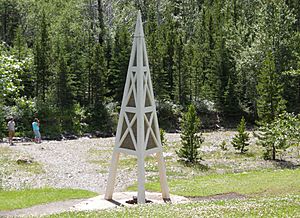First Oil Well in Western Canada facts for kids
Quick facts for kids First Oil Well in Western Canada |
|
|---|---|

marker at the well location
|
|
| Location | Alberta, Canada |
| Established | 1965 |
| Founder | Natural History Branch, Geological Survey of Canada |
| Built | 1902 |
| Governing body | Parks Canada |
| Website | Parks Canada page |
| Official name: First Oil Well in Western Canada National Historic Site | |
| Designated | 17 May 1965 |
| Lua error in Module:Location_map at line 420: attempt to index field 'wikibase' (a nil value). | |
The First Oil Well in Western Canada, also known as Lineham Discovery Well No. 1, is an old oil well. It is now a special place called a National Historic Site of Canada. This site remembers when oil was first found here on September 21, 1902. This happened in what is now Waterton Lakes National Park, Alberta. This well, drilled in 1902, was the first successful oil well in Western Canada.
Contents
Finding Oil in Western Canada
The Lineham Discovery Well No. 1 was drilled by a team of people. These included John Lineham, a businessman from Calgary, and George K. Leeson. Another key person was Kootenay Brown. Their company, the Rocky Mountain Development Company, bought land near Oil Creek (now Cameron Creek). This area was known for natural oil seeps, where oil would leak out of the ground.
People had tried to find oil here before, in the early 1890s, but they were not successful. Lineham's team started drilling in November 1901. They used a special wooden drilling rig. A powerful 35-horsepower steam engine ran the rig.
The Big Discovery
On September 21, 1902, they struck oil! The well was about 311 metres (1,020 ft) deep. It started producing a lot of oil, about 300 barrels per day (48 m3/d) every day. This was a very exciting discovery for Western Canada.
However, the well soon had problems. The metal pipe lining the well, called the casing, broke. The hole became blocked with dirt and drilling tools. In 1904, they managed to clear it and put in a pump. But the tools got stuck again, and the well had to be left. You can still see the old tools stuck in the well today. In total, the well produced about 8,000 barrels (1,300 m3) of oil.
After the Discovery
Even before the well got blocked, it was producing less oil. Other attempts to find more oil nearby were not successful. Most of the drilling sites in the area were abandoned by 1908.
However, the search for oil continued further north in Alberta. This led to the discovery of the Turner Valley oil field in 1914. The oil found at Oil Creek likely came from oil that moved up through cracks in the rocks. This happened because of a large geological event called the Lewis Overthrust. In this event, older rocks were pushed over younger rocks that contained oil. More oil was later found in the Waterton area at the Pincher Creek oil field in 1948.
A National Historic Site
In 1965, the First Oil Well in Western Canada was named a site of national importance. A small monument was placed over the well in 1968. This monument looks like a drilling rig. It helps people remember this important part of Canadian history.

